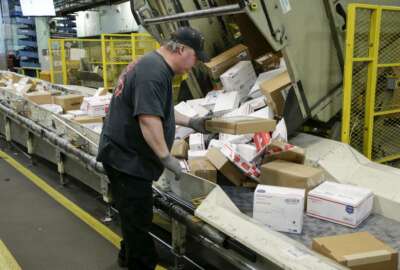
USPS employee satisfaction falls behind competitors, IG analysis finds
As the Postal Service tries to reduce turnover for its non-career workforce, its inspector general finds employee satisfaction is slipping, compared to similar...
As the Postal Service tries to reduce turnover for its non-career workforce, its inspector general finds employee satisfaction is slipping, compared to similar positions in federal agencies and the private sector.
USPS employees cite good pay and benefits as reasons to stay, but long hours and poor work-life balance as reasons to leave, according to an analysis of ratings from the websites Glassdoor and Indeed conducted by the USPS IG office.
USPS, as part of its 10-year reform plan, is trying to reduce the turnover rate of its non-career workforce, which ranged between 36% and 43% between fiscal years 2016 and 2021.
The agency points to critical workforce shortages as the reason for delivery and performance issues amid the COVID-19 pandemic. Those performance issues become most apparent during last year’s peak holiday season. Postmaster General Louis DeJoy called those delays “unacceptable,” and ramped up preparations for this year’s holiday season earlier than before.
The IG report, however, finds USPS has yet to meet its target of reducing non-career turnover to about 34% over the past five years, although turnover is down from a peak of nearly 43% in FY 2016.

Turnover among career employees is only about 6% to 8%, mostly due to retirements. Excluding retirements, USPS says its career employee turnover rate is 2%.
In both 2017 and 2021, the average overall ratings for USPS on Glassdoor and Indeed were lower than the scores at shipping and logistic companies and compared to employees at the Veterans Affairs Department and the Social Security Administration.
Ratings for other shipping and logistics companies also declined or stayed the same during this period, but these ratings fell at a slower rate and generally remained higher than the Postal Service’s ratings.
Career employees, which make up 77% of the USPS workforce and receive full federal benefits, rated the agency more favorably overall than the non-career workforce, which doesn’t receive full federal benefits or job protections associated with career positions.
Career USPS employees gave the agency an average 3.0 rating on Glassdoor in FY 2021, and 36% of career workers gave USPS a four or five-star rating. That, however, falls short of the 48% of career employees who gave USPS high marks in 2017.

The percentage of employees who would recommend taking a job with USPS has also steadily decreased. An IG analysis of Glassdoor and Indeed data found 27% of careers employees would recommend working at USPS, compared to 22% of non-career employees.
USPS Vice President of Human Resources Simon Storey told the IG office its conclusions were “exaggerated and overstated,” and based on a relatively small sample of more than 1,400 USPS career and non-career employees.
The agency also says data from Indeed and Glassdoor doesn’t compare to findings from its internal data taken from USPS employee surveys.
“The cited survey results are limited to the specific demographic that uses sites like Indeed and Glassdoor. It does include employees enjoying a 30, 40, or even 50-year career with the Postal Service,” Storey said.
Meanwhile, USPS ranked among the top 100 large employers in 32 states, according to a recent Forbes survey.

The IG report also coincides with USPS efforts to reduce turnover among its non-career workforce.
Postmaster General Louis DeJoy recently told employees in a video message that he plans to hire 40,000 seasonal workers and convert 33,000 non-career employees to career status ahead of its year-end peak holiday operations. He said the agency hires, on average, about 10,000 new employees each month.
USPS has introduced a new initiative aimed at improving non-career improving non-career retention within the first 90 days of hiring.
The initiative specifically focuses on improving the onboarding and training process. More than 30% of new non-career workers leave during the first 90 days on the job.
Non-career employees said they understood how their work contributed to the agency’s success but quit “due to a lack of schedule flexibility, dislike of their supervisors, and the physical demands of their jobs,” the IG report states.
USPS scored highest on questions about compensation and purpose in Indeed’s Work-Happiness Survey, but received the lowest score on questions regarding stress, management and flexibility.
Aside from ongoing initiatives to reduce turnover, USPS recently signed a negotiated service agreement with NALC that automatically converts city carrier assistants to career status after 24 months of service.
“The Postal Service believes the initiatives that we have been working on will lead to stabilizing our workforce and reduction in our non-career employee separation rate,” Storey wrote.
While USPS casts doubts on data from Glassdoor and Indeed, the IG report also finds concerning workforce trends from agency workforce surveys.
According to the FY 2020 Postal Pulse Survey, three-quarters of respondents reported feeling either unengaged or actively disengaged with their work.
Only 35% to 40% of respondents said they received recognition or praise for doing good work in the past week, and 26% to 30% of respondents said they didn’t think their supervisor, or someone else at work, cared about them. Only 25% of respondents in FY 2020 told USPS they felt engaged at their jobs.
Since 2007, USPS has increased its hiring of non-career employees to offset rising compensation costs associated with career employees. Non-career USPS positions include mail handler assistants, postal support employees, city carrier assistants and rural carriers associates.
Each of the four major crafts — mail handlers, clerks, city carriers and rural carriers — have their own process for converting employees from non-career to career status.
Between 8% and 26% of all non-career employees converted each year between FY 2016 and FY 2020.
Copyright © 2025 Federal News Network. All rights reserved. This website is not intended for users located within the European Economic Area.
Jory Heckman is a reporter at Federal News Network covering U.S. Postal Service, IRS, big data and technology issues.
Follow @jheckmanWFED





